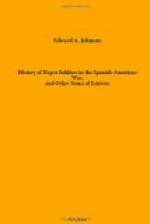After the battles of El Caney and San Juan Hill, many wounded American soldiers who were able to travel were given furloughs to their respective homes in the United States, and Lieutenant Thomas Roberts, of this city, was one of them. Shortly after Lieutenant Roberts arrived in the city he was interviewed by a representative of the Illinois State Register, to whom he gave a description of the battle of July 1st. He said: “On the night of June 30th the second squadron of the Tenth Cavalry did outpost duty. Daylight opened on the soon-to-be blood-sodden field on July 1st, and the Tenth was ordered to the front. First went the first squadron, followed soon after by the second, composed of Troops G, I, B and A. The Tenth Cavalry is composed of Negroes, commanded by white officers, and I have naught but the highest praise for the swarthy warriors on the field of carnage. Led by brave men, they will go into the thickest of the fight, even to the wicked mouths of deadly cannon, unflinchingly.”
Lieutenant Roberts says further that “at 9 o’clock on the morning of July 1st the order came to move. Forward we went, until we struck a road between two groves, which road was swept by a hail of shot and shell from Spanish guns. The men stood their ground as if on dress parade. Single file, every man ready to obey any command, they bade defiance to the fiercest storm of leaden hail that ever hurtled over a troop of United States cavalry. The order came, ‘Get under cover,’ and the Seventy-first New York and the Tenth Cavalry took opposite sides of the road and lay down in the bushes. For a short time no orders came, and feeling a misapprehension of the issue, I hastened forward to consult with the first lieutenant of the company. We found that through a misinterpreted order the captain of the troop and eight men had gone forward. Hastening back to my post I consulted with the captain in the rear of Troop G, and the quartermaster appeared upon the scene asking the whereabouts of the Tenth Cavalry. They made known their presence, and the quartermaster told them to go on, showing the path, the quartermaster led them forward until the bend in the San Juan River was reached. Here the first bloodshed in the Tenth occurred, a young-volunteer named Baldwin fell, pierced by a Spanish ball.”
An aide hastened up and gave the colonel of the regiment orders to move forward. The summit of the hill was crowned by two block-houses, and from these came an unceasing fire. Lieutenant Roberts said he had been lying on the ground but rose to his knees to repeat an order, “Move forward,” when a mauser ball struck him in the abdomen and passed entirely through his body. Being wounded, he was carried off of the field, but after all was over, Lieutenant Roberts says it was said (on the quiet, of course) that “the heroic charge of the Tenth Cavalry saved the ‘Rough Riders’ from destruction.” Lieutenant Roberts says he left Cuba on the 12th of July for Fort Monroe, and that a wounded Rough Rider told him while coming over that “had it not been for the Tenth Cavalry the Rough Riders would never passed through the seething cauldron of Spanish missiles.” Such is the statement of one of Springfield’s best citizens, a member of the Tenth Cavalry, United States regulars.




